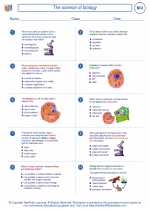Sound
Sound is a form of energy that is produced by vibrations. When an object vibrates, it causes the air particles around it to vibrate. These vibrating air particles then create a series of compressions and rarefactions that travel through the air as a sound wave. When these waves reach our ears, they cause the eardrum to vibrate, which our brain interprets as sound.
Properties of Sound
There are several properties of sound that are important to understand:
- Frequency: This refers to the number of vibrations per second and is measured in hertz (Hz). Higher frequency sounds are perceived as higher pitched, while lower frequency sounds are perceived as lower pitched.
- Amplitude: This refers to the intensity or loudness of a sound and is measured in decibels (dB). Greater amplitude results in louder sounds, while smaller amplitude results in quieter sounds.
- Wavelength: This is the distance between two consecutive compressions or rarefactions in a sound wave. It is inversely related to frequency, meaning that higher frequency sounds have shorter wavelengths and vice versa.
- Speed: Sound travels at different speeds through different mediums. In air at room temperature, sound travels at approximately 343 meters per second.
How Sound is Produced and Detected
Sound can be produced by a variety of sources, including musical instruments, human voices, and natural phenomena. When an object vibrates, it causes the surrounding air to vibrate, producing sound waves that travel through the air until they reach a listener's ear.
Our ears are designed to detect these sound waves. The outer ear collects the sound and directs it into the ear canal, where it hits the eardrum and causes it to vibrate. These vibrations are then transmitted through the middle ear to the cochlea, a fluid-filled organ in the inner ear that contains hair cells. These hair cells convert the vibrations into electrical signals that are sent to the brain, where they are interpreted as sound.
Uses of Sound
Sound has a wide range of practical applications, including communication, entertainment, and medical diagnostics. It is essential for human speech, music, and the operation of devices like sonar and ultrasound machines.
Study Guide
When studying the topic of sound, it's important to focus on the following key points:
- Understand the basic properties of sound, including frequency, amplitude, wavelength, and speed.
- Learn how sound is produced and transmitted through the air, as well as how it is detected by the human ear.
- Explore the various uses of sound in everyday life and in different fields such as music, communication, and technology.
- Practice solving problems related to sound waves, including calculating frequency, wavelength, and speed of sound in different mediums.
- Consider conducting experiments or demonstrations to observe the behavior of sound waves and how they interact with different materials and environments.
By mastering these concepts and skills, you will develop a strong understanding of the principles of sound and its significance in the world around us.
[Sound] Related Worksheets and Study Guides:
.◂Biology Worksheets and Study Guides High School. The science of biology

 Worksheet/Answer key
Worksheet/Answer key
 Worksheet/Answer key
Worksheet/Answer key
